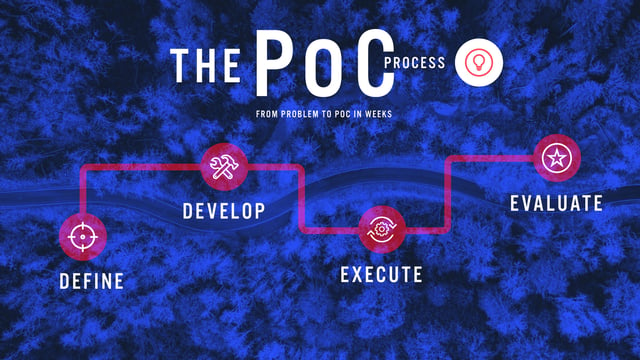Successful IoT implementations are on the rise for enterprises everywhere. By 2020, McKinsey expects the IoT market to reach at least $581B and for corporate IoT to grow at a compound annual growth rate between 7 percent and 15 percent. However, championing digital transformation in any organization requires a strategy.
To protect investments, business interests, future opportunities, and reputations key stakeholders must first identify an opportunity area. IoT can save an enterprise costs in operations or can help open new streams of revenue. The next step is to conduct extensive research on emerging technology and partners; then move forward with a viable plan. After initial research is conducted and a business strategy is defined, one of the best options for introducing a new solution or product to an organization is the proof of concept.
While the proof of concept is typically not the first recommended step in a digital transformation process, many experts agree that it is critical.
 In the Losant Guide: IoT from concept to production, our experts recommend selecting a problem and selecting partners before beginning a proof of concept project. Download the guide.
In the Losant Guide: IoT from concept to production, our experts recommend selecting a problem and selecting partners before beginning a proof of concept project. Download the guide.
IoT Proof of Concept Projects Are Becoming More Successful
In 2017, Cisco commissioned a study and learned that nearly two-thirds of enterprise IoT projects stalled at the proof of concept phase. This past August, Microsoft released a similar study, which revealed that now roughly 30 percent of IoT projects stalled at the proof of concept phase. If you look beyond the failures, you will see that now more than half of IoT projects that get started are moving forward. In both instances, the stakeholders in the surveys mentioned that successful projects are related to partnering with IoT experts, or acquiring teams with IoT-specific talent.
What Is an IoT Proof of Concept?
A proof of concept is a low-risk way to identify IoT opportunities in an organization because it requires a limited timeline and a budget. To begin a proof of concept, an organization must have an opportunity, question, or problem it is seeking to solve with IoT. Once the opportunity and the measure of success are defined, the team of experts can experiment with an IoT solution in its intended environment. The team tests out different hardware if needed, builds an end-to-end solution, and then evaluates the results to the measure of success outlined in the beginning. A PoC can help enterprises determine if the product or solution they seek to develop reaches the goals they set out to reach.
Why Begin a Proof of Concept?
There are quite a few reasons to begin an IoT project with a proof of concept.
- It is a low-risk way to experiment (limited timeline and budget)
- Helps teams prove business value with real data
- Helps teams achieve leadership buy-in
- Provides data about how hardware will perform
- Provides proof of IoT platform
- Helps teams learn where partner expertise is needed and how to evaluate partners
Full-scale IoT implementation is not always the result of a successful PoC. Sometimes, the result is learning that more infrastructure needs to be built to accept IoT data and support a full-scale IoT implementation. Even an unsuccessful PoC can kick-start the next PoC which might have a similar end goal with a different approach. The data collected from the initial PoC can uncover ideas for new products and services.
How Is a Proof of Concept Executed?
Executing a proof of concept involves four steps: Define, Develop, Execute and Evaluate.
1. Define - Collaborate with your internal team and IoT experts to define goals, inputs, metrics, scope, risks, and a schedule. One of the most critical steps is to use this team to define success that the project will consistently be measured against.
2. Develop - Create an execution plan. An IoT solution requires hardware (sensors, gateways), a platform (software) and connectivity. Select hardware for your organization’s environment, configure software and determine which connectivity partners will work for the IoT solution. Data could move from cloud to cloud via MQTT or HTTP; or through the local environment using edge computing. Once the path is understood, a team can implement concepts and ensure the definition of success is still appropriate and measurable.
3. Execute - Execute the plan. Secure the required parts and install hardware in the environment according to the plan. Build the end-to-end IoT solution. Collect data, implement concepts, and clarify the definition of success to ensure the results can be evaluated.
4. Evaluate - Review results and compare outcomes to success criteria. If a PoC does not solve the problem, prove the concept or work in its intended design, it has still served its purpose. The point of this exercise is to learn whether the technology can solve the problem on a small scale. After the PoC has been completed or the project can then be adjusted, and a team can develop a full execution plan and align on a way to move forward.
|
Download our helpful PoC Process Worksheet. (431 KB) |
Results of a Real-World IoT Proof of Concept

The Cincinnati/Northern Kentucky International Airport (CVG) is committed to providing the best experience for the millions of travelers that use the airport. According to third-party research, clean restrooms contribute to the best traveler experience. With data to support this goal, the airport team focused on introducing an IoT solution to improve restroom cleanliness and tapped Losant to assist.
Losant encouraged CVG to start small and begin with a proof of concept in one restroom. The goal of the first PoC was to understand restroom traffic by using technology to learn when paper goods were depleted. This information would then be sent to the Losant Enterprise IoT Platform, and trigger a workflow that would alert staff to replenish the paper goods. However, the original hardware could not operate due to the dust in the paper dispensers.
This was a great example of how a proof of concept can get an organization to learn that a solution does not work in less time. Instead of wasting money and resources on ordering hardware that wouldn’t work, the PoC exposed an issue, which at the PoC level, did not majorly impact the organization’s budget because it only affected one bathroom instead of several. The team launched a new PoC that revealed another way to tally restroom traffic data -with a laser on the door’s threshold. After a certain number of visitors use a restroom, the information is reported to Losant, which triggers alerts to smartwatches worn by internal cleaning staff. As a result of this PoC, the staff is better utilized for cleaning in response to demand instead of on a schedule. Previously, facilities staff could be wasting time cleaning a clean bathroom or not responding to a dirty bathroom in an appropriate amount of time. In addition, the original goal of achieving clean restrooms and overall traveler satisfaction was achieved with the IoT solution.
We encourage all of our clients to start with a PoC or an analysis to clearly define the project goals. A project with a controlled budget, timeline, and goal helps an enterprise evaluate if the technology can collect desired information, and whether Losant is the best platform for short and long-term goals. If you would like to begin a proof of concept or learn more about how IoT can benefit your organization, contact one of our Solutions Engineers.

